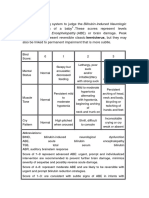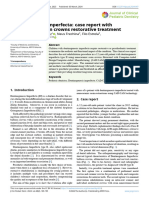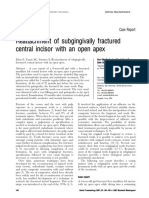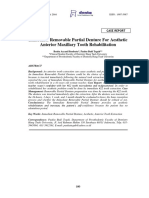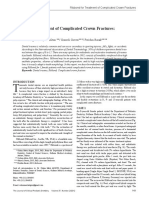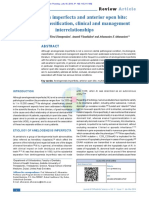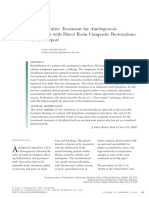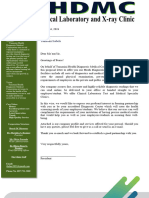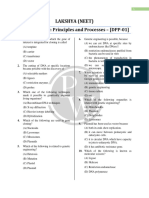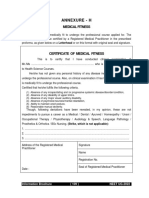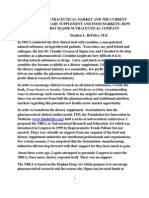Amelogenesis Imperfecta-A Prosthetic Rehabilitation: A Clinical Report
Amelogenesis Imperfecta-A Prosthetic Rehabilitation: A Clinical Report
Uploaded by
Melisa GuerraCopyright:
Available Formats
Amelogenesis Imperfecta-A Prosthetic Rehabilitation: A Clinical Report
Amelogenesis Imperfecta-A Prosthetic Rehabilitation: A Clinical Report
Uploaded by
Melisa GuerraOriginal Title
Copyright
Available Formats
Share this document
Did you find this document useful?
Is this content inappropriate?
Copyright:
Available Formats
Amelogenesis Imperfecta-A Prosthetic Rehabilitation: A Clinical Report
Amelogenesis Imperfecta-A Prosthetic Rehabilitation: A Clinical Report
Uploaded by
Melisa GuerraCopyright:
Available Formats
Amelogenesis imperfecta—a prosthetic rehabilitation: A clinical report
Dominique Bouvier, Dr Odont, PhD,a Jean-Pierre Duprez, Dr Odont, PhD,b Christian Pirel, Dr Odont,
PhD,c and Bernard Vincent, Dr Odont, PhDd
Faculty of Odontology, University of Claude Bernard Lyon I, Lyon, France
Amelogenesis imperfecta is an inherited disease that
disturbs the formation of the enamel. It can occur as 2
main types, hypocalcification and hypoplasia. Enamel
hypocalcification is a defect in the mineralization;
hypoplasia is a defect in the formation of the enamel
matrix. Both deciduous and permanent teeth are affect-
ed, and the disorder may create unesthetic appearance,
dental sensitivity, and attrition. Numerous treatments
have been described for rehabilitation of amelogenesis
imperfecta in adults1-4 and children.5-8
This clinical report describes the stages in the com-
plete restoration of amelogenesis imperfecta in a child
between the ages of 7 and 12.
CLINICAL REPORT Fig. 1. View of mixed dentition before treatment.
A 7-year-old boy who suffered from considerable
sensitivity and was very self-conscious about the
appearance of his teeth was referred to the department
of pediatric dentistry for treatment. He was diagnosed
with hereditary amelogenesis imperfecta. On examina-
tion, the patient had mixed dentition; first molars and
permanent incisors had erupted, the teeth were found
to possess little enamel, and crowns were thin and
short. The child had good oral hygiene, was caries-free,
and did not exhibit any periodontal problems. Attrition
of the molars had resulted in a decrease of the vertical
dimension of occlusion (Figs. 1 and 2).
Temporary treatment
The first phase of treatment lasted for a period of
more than 3.5 years. Treatment consisted of fitting pre- Fig. 2. Panorex before treatment.
formed Ni-Cr crowns (ION, 3M Dental Products, St
Paul, Minn.) on the first permanent molars and on the
second deciduous molars to stabilize the occlusion and resin crowns. Six months later, the second molars
to halt attrition. No attempt was made to increase the erupted and were fitted with Ni-Cr crowns. Pulp vital-
vertical dimension of occlusion. Maxillary and ity was maintained for all the teeth. Third molar tooth
mandibular incisors were fitted with carboxylate resin germs were removed as a preventive measure.
crowns (ION, 3M Dental Products) to improve At this point, it was decided to increase the vertical
appearance and decrease sensitivity. Five appointments dimension of occlusion. A wax-up of the mandibular
were required for treatment. molars and premolars was made in the laboratory. The
During the following 22-month period, the child wax-up was duplicated and a vacuum-formed matrix was
was monitored for eruption of permanent teeth, and fabricated. The matrix was used to produce 2 temporary
the premolars and canines were fitted with carboxylate autopolymerizing resin mandibular fixed prostheses
directly in the patient’s mouth, and adjustment of the
new occlusion was carried out immediately afterward.
aFormer Assistant Hospital Practitioner, Department of Dentistry.
bAssociate
Occlusal height was increased 2 mm at the incisors. The
Professor, Department of Pediatric Dentistry.
cProfessor, Department of Prosthodontics. patient was then monitored systematically over a 3-month
dAssociate Professor, Department of Prosthodontics. period to check for any functional or articulatory problem
J Prosthet Dent 1999;82:130-1. following the change in vertical dimension of occlusion.
130 THE JOURNAL OF PROSTHETIC DENTISTRY VOLUME 82 NUMBER 2
BOUVIER ET AL THE JOURNAL OF PROSTHETIC DENTISTRY
Transitional treatment
Transitional treatment spanned 8 weeks. At 12 years
of age, the patient was ready for the second prosthetic
phase. Jaw relation was recorded with wax wedges
(Moyco Industries Inc, Philadelphia, Pa.). Because of
the difficulty in managing a young patient, 2-stage
impressions (Express 3M dental products) were made on
each arch and from these, impression copings (Duralay
resin) on teeth and individual trays covering them, were
made in the laboratory in preparation for final impres-
sions. Impression copings were secured by Duralay resin
in groups of 3 or 4 copings. Cervical adjustment of the
impression copings on the preparations was checked in
the patient’s mouth and the final impression was made
for each arch. Impression copings were first filled with Fig. 3. View of prostheses 6 months after fitting.
syringed impression material (3M Express, 3M Dental
Products) and placed on the prepared teeth. Then, indi-
vidual trays were filled with medium consistency impres-
sion material (3M Express, 3M Dental Products) and goal is to establish an esthetic appearance and efficient
placed in position over the complete set of impression masticatory function until adulthood.
copings. When the impression material had set, the cop- In treating amelogenesis imperfecta in children, it is
ings and trays were removed together. important to allow for mandibular and maxillary
From these impressions, casts were made and growth9 by using individual restorations on teeth.
mounted in an articulator to produce 24 individual We wish to thank the firm having produced the prosthesis in the
frameworks for ceramic-metal crowns and 4 alloy laboratory (Société Pfeffer), Professor D. Bois, and the Hospices
crowns for the second molars. The precious alloy used Civils de Lyon for their financial support.
was 73.8% gold and 9.0% platinum by weight
(Degunorm, Degussa AG, Hanau, Germany). The REFERENCES
frameworks were tried in the patient’s mouth to check 1. Rada ER, Hasiakos PS. Current treatment modalities in the conservative
the marginal fit and centric relation position. The cos- restoration of amelogenesis imperfecta: a case report. Quintessence Int
metic coating, a low-fusion ceramic (Ducera, Degussa 1990;21:937-42.
2. Greenfield R, Iacono V, Zove S, Baer P. Periodontal and prosthodontic
AG), was then applied. A fitting session, before the treatment of amelogenesis imperfecta: a clinical report. J Prosthet Dent
glazing of the ceramic material, enabled final occlusal 1992;68:572-4.
refinement. The crowns were then finished in the labo- 3. Konis AB. Treatment of enamel hypoplasia in young adults. NY State Dent
J 1993;59:38-40.
ratory and cemented with glass ionomer cement (Fuji I, 4. Lumley PJ, Rollings AJ. Amelogenesis imperfecta: a method of recon-
GC Corporation, Tokyo, Japan). struction. Dent Update 1993;20:252-5.
The patient was monitored at 3-month intervals for 5. Bedi R. The management of children with amelogenesis imperfecta.
Restorative Dent 1989;5:31-4.
1 year (Fig. 3), and then once a year. 6. Mackie IC, Blinkhorn AS. Amelogenesis imperfecta: early interception to
prevent attrition. Dent Update 1991;18:79-80.
SUMMARY 7. Wright JT, Waite P, Mueninghoff L, Sarver DM. The multidisciplinary
approach managing enamel defects. J Am Dent Assoc 1991;122:62-5.
The rehabilitation of amelogenesis imperfecta in a 8. Bouvier D, Duprez JP, Bois D. Rehabilitation of young patients with amel-
child must take into account the development of the ogenesis imperfecta: a report of two cases. ASDC J Dent Child 1996;
child’s teeth, the health of the periodontal tissues, and 63:443-7.
9. Planas P. La réhabilitation neuro-occlusale. Paris: Masson; 1992. p. 23-
the mandibular and maxillary growth. As demonstrated 44.
in this clinical report, this was performed in 2 stages.
The immediate temporary treatment, during the Reprint requests to:
DR DOMINIQUE BOUVIER
period of mixed dentition, is designed to reduce sensi- 115 RUE TÊTE D’OR
tivity in the teeth, prevent attrition of erupting teeth, 69006 LYON
and restore appearance and masticatory function. Dur- FRANCE
FAX: 33-4-72-74-92-03
ing this first phase, the vertical dimension of occlusion
was increased if necessary. It is essential to monitor this Copyright © 1999 by The Editorial Council of The Journal of Prosthetic
new occlusion closely over several months and to con- Dentistry.
0022-3913/99/$8.00 + 0. 10/1/99195
serve pulp vitality in immature permanent teeth so they
can complete their growth cycle.
The second stage involves the transitional treatment
and begins when all permanent teeth are in place. The
AUGUST 1999 131
You might also like
- BIND ScoreDocument2 pagesBIND Scoremahi_elsemary701175% (4)
- Dementia in DI British SocietyDocument87 pagesDementia in DI British SocietyLucyRainNo ratings yet
- Filipino Indigenous Medicine From Tradition To Mainstream PracticeDocument59 pagesFilipino Indigenous Medicine From Tradition To Mainstream PracticeRodel B. Arada0% (1)
- Jo CPD 2023050602Document7 pagesJo CPD 2023050602Andreea IoanaNo ratings yet
- Avulsed TeethDocument3 pagesAvulsed TeethSimona DobreNo ratings yet
- Sefalo 3Document6 pagesSefalo 3Aisha DewiNo ratings yet
- Artigo 18Document4 pagesArtigo 18Gabriela PizziNo ratings yet
- Caso 3 AtriciónDocument8 pagesCaso 3 AtriciónCristian PadillaNo ratings yet
- Department of Pediatric & Preventive DentistryDocument3 pagesDepartment of Pediatric & Preventive DentistryRenieKumalaNo ratings yet
- DENTINOGENESIS IMPERFECTA Edelhoff - Brix - Schweiger Dentinogenesis Imperfecta Clinical CaseDocument5 pagesDENTINOGENESIS IMPERFECTA Edelhoff - Brix - Schweiger Dentinogenesis Imperfecta Clinical Casehermesugalde70No ratings yet
- Management of Severe Dento-Alveolar Traumatic Injuries in A 9-YeaDocument7 pagesManagement of Severe Dento-Alveolar Traumatic Injuries in A 9-YeasintaznNo ratings yet
- Inflammatory Dentigerous Cyst Management in Paediatric Patient Followed by Management of Impacted Maxillary Canine With 1 Year Follow Up: A Rare CaseDocument5 pagesInflammatory Dentigerous Cyst Management in Paediatric Patient Followed by Management of Impacted Maxillary Canine With 1 Year Follow Up: A Rare Casedrzana78No ratings yet
- Controlled Tooth Movement To Correct An Iatrogenic Problem: Case ReportDocument8 pagesControlled Tooth Movement To Correct An Iatrogenic Problem: Case ReportElla GolikNo ratings yet
- A Clinical Study of Direct Composite Full-Coverage Crowns: Long-Term ResultsDocument10 pagesA Clinical Study of Direct Composite Full-Coverage Crowns: Long-Term ResultsKartika KurniasariNo ratings yet
- Conservative Management of a Dentigerous Cyst Associated with an Impacted Mandibular Second Premolar in MixedDocument5 pagesConservative Management of a Dentigerous Cyst Associated with an Impacted Mandibular Second Premolar in Mixedtranphuongthao311099No ratings yet
- Treatment of Avulsed Teeth With Emdogain - A Case ReportDocument3 pagesTreatment of Avulsed Teeth With Emdogain - A Case ReportbaridinoNo ratings yet
- Case Report Gigi Tiruan LengkapDocument3 pagesCase Report Gigi Tiruan LengkapGus BasyaNo ratings yet
- 724 2683 4 PB PDFDocument2 pages724 2683 4 PB PDFCristi GaidurNo ratings yet
- Shortened Dental ArchDocument5 pagesShortened Dental Archsarah wilderNo ratings yet
- Cekic Nagas2016 PDFDocument8 pagesCekic Nagas2016 PDFAkanksha MahajanNo ratings yet
- An Integrated Treatment Approach: A Case Report For Dentinogenesis Imperfecta Type IIDocument4 pagesAn Integrated Treatment Approach: A Case Report For Dentinogenesis Imperfecta Type IIpritasyaNo ratings yet
- Per I OoooooDocument7 pagesPer I OooooorisjunNo ratings yet
- 2016 SergioDocument10 pages2016 SergioazizhamoudNo ratings yet
- Tooth TtriyionDocument5 pagesTooth TtriyionDhanasriNo ratings yet
- Article - 1653239529 2Document5 pagesArticle - 1653239529 2Mega AzzahraNo ratings yet
- Endodontic Manaegement of A Patient With Amelogenesis ImperfectaDocument23 pagesEndodontic Manaegement of A Patient With Amelogenesis ImperfectaDrSnehangshu DuttaNo ratings yet
- Prosthodontic Rehabilitation of Compromised UpperDocument6 pagesProsthodontic Rehabilitation of Compromised UpperAakruti mashettiwarNo ratings yet
- Treatment of Maxillary Canine TranspositionDocument8 pagesTreatment of Maxillary Canine TranspositionFabian BarretoNo ratings yet
- Adj 12563Document5 pagesAdj 12563anushiNo ratings yet
- ArticuloDocument4 pagesArticuloanaNo ratings yet
- Examination of Antimicrobial and AntiinfDocument66 pagesExamination of Antimicrobial and AntiinfCristina CapettiNo ratings yet
- Miyahira2008 - Miniplates As Skeletal Anchorage For Treating Mandibular Second Molar ImpactionsDocument4 pagesMiyahira2008 - Miniplates As Skeletal Anchorage For Treating Mandibular Second Molar ImpactionsNathália LopesNo ratings yet
- Ortodoncia y CarillasDocument4 pagesOrtodoncia y CarillasLiz StephanyNo ratings yet
- RK 1Document5 pagesRK 1dion leonardoNo ratings yet
- 322 1403 1 PB PDFDocument2 pages322 1403 1 PB PDFAdityaNo ratings yet
- Manuscript of Case Report On Amelogenesis ImperfectaDocument12 pagesManuscript of Case Report On Amelogenesis ImperfectaIndrani DasNo ratings yet
- Dental Clinics Vol.59 No.3 P.689-702 July 2015Document14 pagesDental Clinics Vol.59 No.3 P.689-702 July 2015Mohammad IbrahimNo ratings yet
- Zona Neutra Maxilofacial PacienteDocument6 pagesZona Neutra Maxilofacial Pacientemargarita de montenegroNo ratings yet
- Straumann Pro Arch DR LevineDocument5 pagesStraumann Pro Arch DR LevineShyam BhatNo ratings yet
- Orthodontic Approach in The Treatment of The Cleft Patient 2002 Oral and Maxillofacial Surgery Clinics of North AmericaDocument14 pagesOrthodontic Approach in The Treatment of The Cleft Patient 2002 Oral and Maxillofacial Surgery Clinics of North Americasara-heshamNo ratings yet
- Management of A Palatal Gingival Groove in A Maxillary Lateral Incisor: A Case ReportDocument4 pagesManagement of A Palatal Gingival Groove in A Maxillary Lateral Incisor: A Case ReporthappykglayNo ratings yet
- Ecde 10 00327Document8 pagesEcde 10 00327Erisa BllakajNo ratings yet
- Restoration of Occlusal Plane and Esthetics in Severely Worn DentitionDocument4 pagesRestoration of Occlusal Plane and Esthetics in Severely Worn DentitionUJ CommunicationNo ratings yet
- Management of Internal Resorption: A Catch-22 Situation: Sahle AK Karanath, IB Geeta, Jayson M JamesDocument5 pagesManagement of Internal Resorption: A Catch-22 Situation: Sahle AK Karanath, IB Geeta, Jayson M JamesMelvinda ZhuoNo ratings yet
- Influence of Age and Apical Diameter On TheDocument6 pagesInfluence of Age and Apical Diameter On ThethaynamodtkowskiNo ratings yet
- Increased Occlusal Vertical Dimension and Its InflDocument9 pagesIncreased Occlusal Vertical Dimension and Its Inflgheorghita.mihaelaaNo ratings yet
- Immediate Removable Partial Denture For Aesthetic Anterior Maxillary Tooth RehabilitationDocument9 pagesImmediate Removable Partial Denture For Aesthetic Anterior Maxillary Tooth RehabilitationMeta Anjany FirmansyahNo ratings yet
- C01251115Document5 pagesC01251115agnes herlinaNo ratings yet
- Open-Cap Acrylic SplintDocument3 pagesOpen-Cap Acrylic SplintFeras Al-ZbounNo ratings yet
- Surgical and Endodontic Management of Large Cystic Lesion: AbstractDocument5 pagesSurgical and Endodontic Management of Large Cystic Lesion: AbstractanamaghfirohNo ratings yet
- Bimaxilary ProtrusionDocument7 pagesBimaxilary ProtrusionD YasIr MussaNo ratings yet
- An Innovative Technique To Restore The Non Vital Teeth With Wide Open Canals - A Clinical StudyDocument4 pagesAn Innovative Technique To Restore The Non Vital Teeth With Wide Open Canals - A Clinical StudyIOSRjournalNo ratings yet
- Article-PDF-sheen Juneja Aman Arora Shushant Garg Surbhi-530Document3 pagesArticle-PDF-sheen Juneja Aman Arora Shushant Garg Surbhi-530JASPREETKAUR0410No ratings yet
- Conservative and Esthetic Management of Diastema Closure Using Porcelain Laminate VeneersDocument5 pagesConservative and Esthetic Management of Diastema Closure Using Porcelain Laminate VeneersLuis Alberto Carpio MorenoNo ratings yet
- 6.clinical Case ReportMultidisciplinary Approach For Rehabilitation of Debilitated Anterior ToothDocument6 pages6.clinical Case ReportMultidisciplinary Approach For Rehabilitation of Debilitated Anterior ToothSahana RangarajanNo ratings yet
- ManuscriptDocument6 pagesManuscriptDivya DahiyaNo ratings yet
- Pin-Retained Restoration With Resin Bonded Composite of A Badly Broken ToothDocument3 pagesPin-Retained Restoration With Resin Bonded Composite of A Badly Broken ToothIOSRjournalNo ratings yet
- Complete Denture Fabrication For Old Denture Wearer in One DayDocument3 pagesComplete Denture Fabrication For Old Denture Wearer in One DayAsma Akram - ProsthodonticsNo ratings yet
- V M A B D D I P AC R: Ertical Andibular Lveolar ONE Istraction and Ental Mplant Lacement: ASE EportDocument5 pagesV M A B D D I P AC R: Ertical Andibular Lveolar ONE Istraction and Ental Mplant Lacement: ASE EportDr. Jalisson VicenteNo ratings yet
- Avultion 1Document7 pagesAvultion 1rajesh kumarNo ratings yet
- Ribbond For Treatment of Complicated Crown Fractures: Report of 3 CasesDocument4 pagesRibbond For Treatment of Complicated Crown Fractures: Report of 3 CasesAmmyNo ratings yet
- IPIntJMedPaediatrOncol 9 2 77 82Document6 pagesIPIntJMedPaediatrOncol 9 2 77 82Laraduta AgustiniNo ratings yet
- Amelogenesis Imperfecta and Anterior Open Bite: Etiological, Classification, Clinical and Management InterrelationshipsDocument6 pagesAmelogenesis Imperfecta and Anterior Open Bite: Etiological, Classification, Clinical and Management InterrelationshipsMelisa GuerraNo ratings yet
- Dental Hypomineralization Treatment: A Systematic Review: ReviewarticleDocument14 pagesDental Hypomineralization Treatment: A Systematic Review: ReviewarticleMelisa GuerraNo ratings yet
- Clinical Success of Deproteinization in Hypocalcified Amelogenesis ImperfectaDocument7 pagesClinical Success of Deproteinization in Hypocalcified Amelogenesis ImperfectaMelisa GuerraNo ratings yet
- A Conservative Treatment For Amelogenesis Imperfecta With Direct Resin Composite Restorations: A Case ReportDocument9 pagesA Conservative Treatment For Amelogenesis Imperfecta With Direct Resin Composite Restorations: A Case ReportMelisa GuerraNo ratings yet
- Cambios en La Calidad de Vida Despues Del Tratamiento de Extracciones Dentales Bajo Anestesia GeneralDocument7 pagesCambios en La Calidad de Vida Despues Del Tratamiento de Extracciones Dentales Bajo Anestesia GeneralMelisa GuerraNo ratings yet
- Milk Supply ChallengesDocument37 pagesMilk Supply ChallengesAlex perrieNo ratings yet
- Xerostomia As A Potential Condition in PDocument4 pagesXerostomia As A Potential Condition in PAlamsyah PiliangNo ratings yet
- DR ObjectivesDocument3 pagesDR Objectivesryan erwin san luisNo ratings yet
- FNCP GroupDocument13 pagesFNCP GroupTanya PinedaNo ratings yet
- Acute Abdominal Pain MS LectureDocument63 pagesAcute Abdominal Pain MS LectureRovanNo ratings yet
- Cardiovascular Pathology IDocument37 pagesCardiovascular Pathology IOyuka OyukNo ratings yet
- ISO 45001 2018 Incident Investigation and Reporting Procedure SampleDocument5 pagesISO 45001 2018 Incident Investigation and Reporting Procedure SampleAmr EssamNo ratings yet
- Discharge PlanDocument2 pagesDischarge Plan2G Balatayo Joshua LeoNo ratings yet
- Obesity Case Study: Obesity Treated With SurgeryDocument60 pagesObesity Case Study: Obesity Treated With SurgeryJenny McDonaldNo ratings yet
- Uw Medical CenterDocument2 pagesUw Medical Centermas bambangNo ratings yet
- Artikel Keluarga Berencana, Izzatul Ummah FhadillaDocument6 pagesArtikel Keluarga Berencana, Izzatul Ummah FhadillaAQFAL storyNo ratings yet
- A Round Ligaments: 1. Which Structure Provides The Major Support To The Uterus and Cervix?Document10 pagesA Round Ligaments: 1. Which Structure Provides The Major Support To The Uterus and Cervix?Nikhil Tyagi100% (1)
- Emergency Medicine PDFDocument141 pagesEmergency Medicine PDFJosephine Tay100% (3)
- Daftar PustakaDocument3 pagesDaftar PustakamariaNo ratings yet
- Lab Proposal LetterDocument1 pageLab Proposal Letterthdmc2024No ratings yet
- Genetic Screening and Prenatal DiagnosisDocument18 pagesGenetic Screening and Prenatal DiagnosisA B ONo ratings yet
- Biotechnology: Principles and Processes - (DPP-01) : Lakshya (Neet)Document5 pagesBiotechnology: Principles and Processes - (DPP-01) : Lakshya (Neet)Ram MeharNo ratings yet
- Article Outbreak NurDocument7 pagesArticle Outbreak Nur2021459072No ratings yet
- Annexure H Med Fitness CertDocument2 pagesAnnexure H Med Fitness CertShakuntala DeviNo ratings yet
- Public Private PartnershipDocument169 pagesPublic Private PartnershipSergio Sepúlveda GallegosNo ratings yet
- Stephen L. DeFelice On The Future of NutraceuticalsDocument9 pagesStephen L. DeFelice On The Future of NutraceuticalsDecrapitationNo ratings yet
- NCP, DS, GenogramDocument11 pagesNCP, DS, GenogramElva Borlado BilocuraNo ratings yet
- Closure of An Intermediate Care Unit Impact On Critical Care UtilizationDocument6 pagesClosure of An Intermediate Care Unit Impact On Critical Care UtilizationJHNo ratings yet
- Patient Care AssignmentDocument1 pagePatient Care AssignmentRhod Bernaldez EstaNo ratings yet
- Abg Need For StudyDocument10 pagesAbg Need For StudyKhirabdhi Tanaya SahuNo ratings yet
- Japid 12 3Document8 pagesJapid 12 3hugorhadelNo ratings yet
- Application of Orem TheoryDocument17 pagesApplication of Orem TheoryKit LaraNo ratings yet
